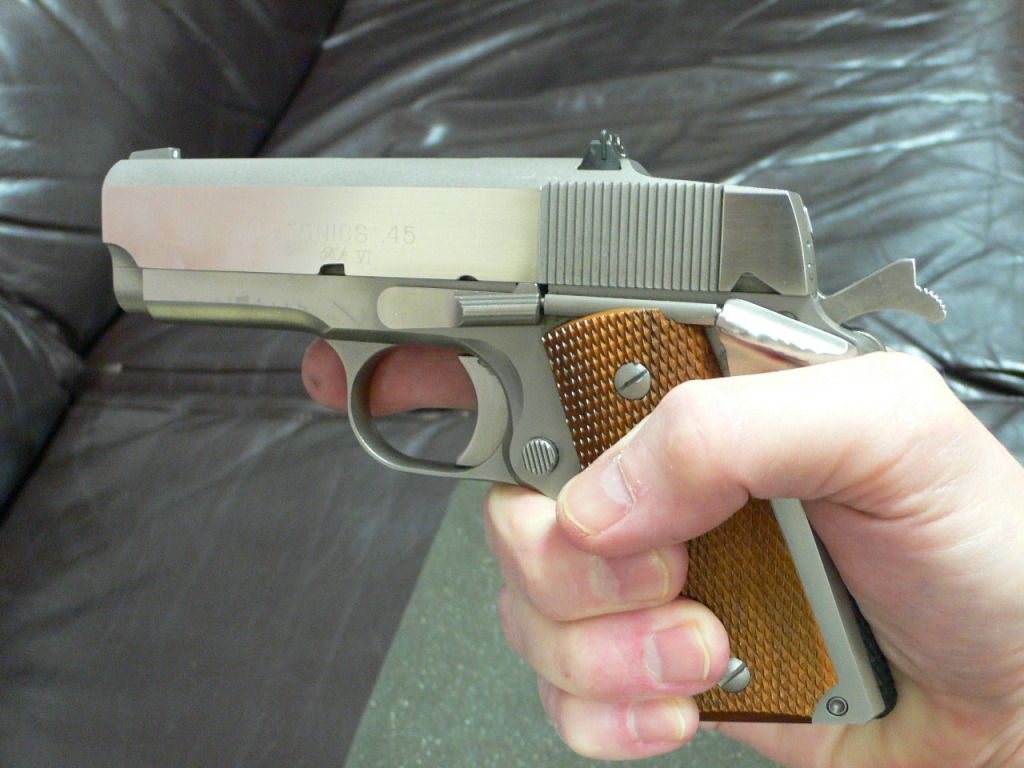 |
| Photo's in this article are by the original author. |
www.watchtryst.com/showthread.php?t=1969
"The Detonics .45 - praise for a legend
As promised, a short treatise on the legendary Detonics .45 ACP pistol, which was and remains my all time favorite .45 auto.
I don't need to get into the efficacy of the .45 ACP round for this. For years after WWII, countless folks were trying to come up with a way to make the basic 1911 Colt-pattern pistol into a smaller package for easier concealment, with varying degrees of (un)success. The problem, mostly, was how to tame the recoil, especially in a pistol that by necessity would have a shorter slide, and thus a shorter travel when cycling. The usual approach was to use a much stiffer spring with buffer pads at the rear end. The downside to this was that although this could help relieve a good deal of the felt recoil to the hand, it made it nearly impossible to use different types of rounds as the cup pressure of the round had to be more or less mated to the particular spring used. It also did nothing to reduce muzzle flip, another big concern.
Long about the early '70's a couple of guys came up with a radical idea for springing a chopped .45. Instead of a single spring captured at the front end by a spring plug mated to a barrel-bushing, use a self-contained multiple spring unit, with the springs counterwound to cancel out the wave-pulse generated when the individual spring is compressed. Make the springs/guide rod/front plug into one self contained unit which never needed disassembly, and while we're at it, get rid of the barrel-bushing (a nuisance part if ever there was one), in favor of a self centering barrel. Keep the rest of the Browning operating system the same; after all, it was nothing if not reliable.
I don't need to get into the efficacy of the .45 ACP round for this. For years after WWII, countless folks were trying to come up with a way to make the basic 1911 Colt-pattern pistol into a smaller package for easier concealment, with varying degrees of (un)success. The problem, mostly, was how to tame the recoil, especially in a pistol that by necessity would have a shorter slide, and thus a shorter travel when cycling. The usual approach was to use a much stiffer spring with buffer pads at the rear end. The downside to this was that although this could help relieve a good deal of the felt recoil to the hand, it made it nearly impossible to use different types of rounds as the cup pressure of the round had to be more or less mated to the particular spring used. It also did nothing to reduce muzzle flip, another big concern.
Long about the early '70's a couple of guys came up with a radical idea for springing a chopped .45. Instead of a single spring captured at the front end by a spring plug mated to a barrel-bushing, use a self-contained multiple spring unit, with the springs counterwound to cancel out the wave-pulse generated when the individual spring is compressed. Make the springs/guide rod/front plug into one self contained unit which never needed disassembly, and while we're at it, get rid of the barrel-bushing (a nuisance part if ever there was one), in favor of a self centering barrel. Keep the rest of the Browning operating system the same; after all, it was nothing if not reliable.




